Assessment of Leadership Style's Role in Employee Engagement Research
VerifiedAdded on 2022/11/14
|15
|3515
|312
Report
AI Summary
This report outlines the research methodology employed to assess the impact of leadership styles on employee engagement. The study utilizes a quantitative research design, justifying the choice over a qualitative approach. It details the sampling design, employing a simple random sampling technique to select 50 employees from Australian workplaces. The report elaborates on the data collection methods, distinguishing between primary and secondary data, and the rationale for choosing probability sampling. Ethical considerations, data validation, and reliability are also addressed. The methodology section provides a comprehensive overview of the research process, including the selection of quantitative methods, sampling design, and data collection strategies used to analyze the relationship between leadership styles and employee engagement. The report highlights the importance of selecting appropriate research approaches to ensure the authenticity and validity of the findings.
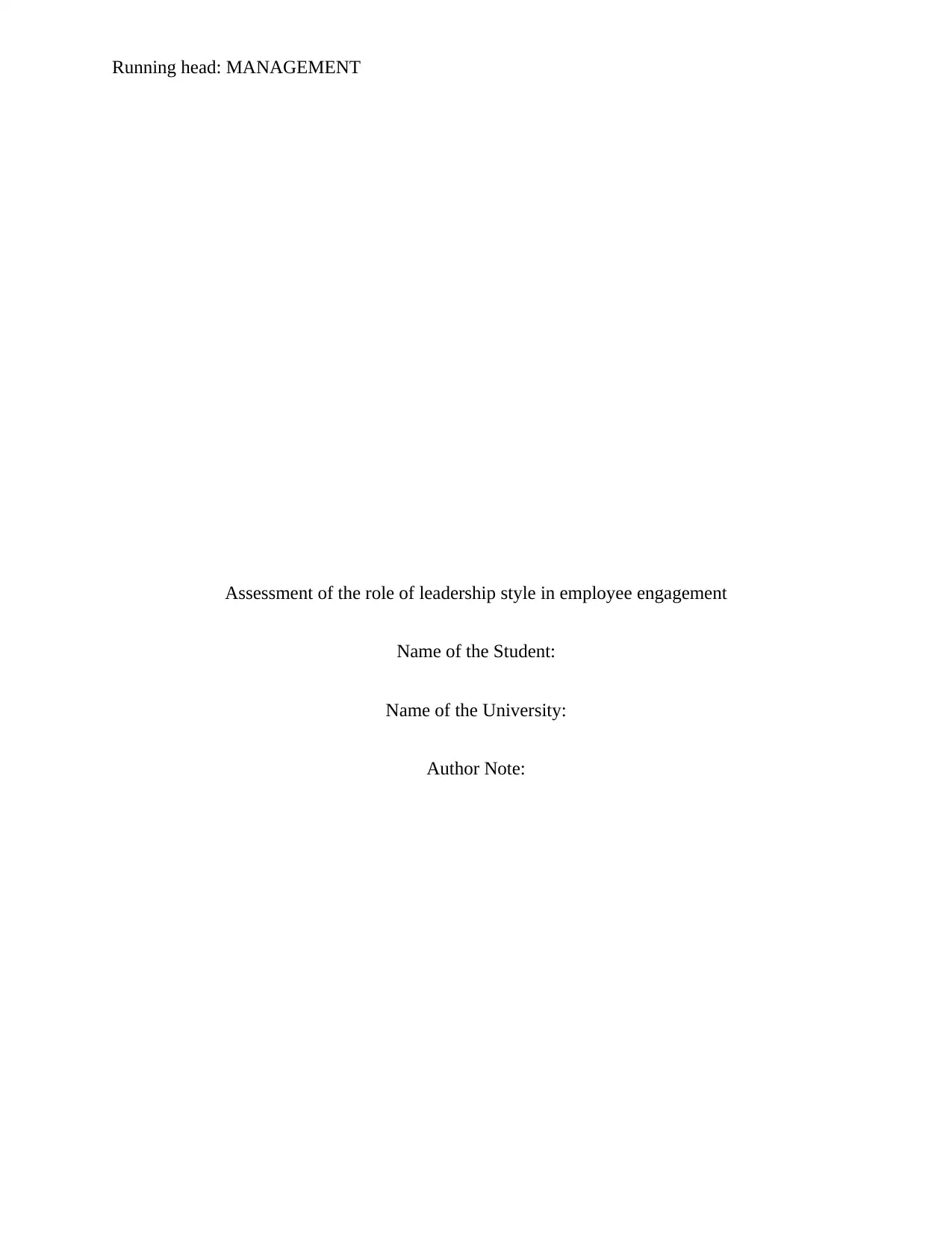
Running head: MANAGEMENT
Assessment of the role of leadership style in employee engagement
Name of the Student:
Name of the University:
Author Note:
Assessment of the role of leadership style in employee engagement
Name of the Student:
Name of the University:
Author Note:
Paraphrase This Document
Need a fresh take? Get an instant paraphrase of this document with our AI Paraphraser

1MANAGEMENT
Abstract:
This research report focuses on the methodology used for assessing role of leadership style in
employee engagement. The report commences by discussing the research design. The report also
discusses about the sampling design, sampling methods and the methods of data collection.
Abstract:
This research report focuses on the methodology used for assessing role of leadership style in
employee engagement. The report commences by discussing the research design. The report also
discusses about the sampling design, sampling methods and the methods of data collection.
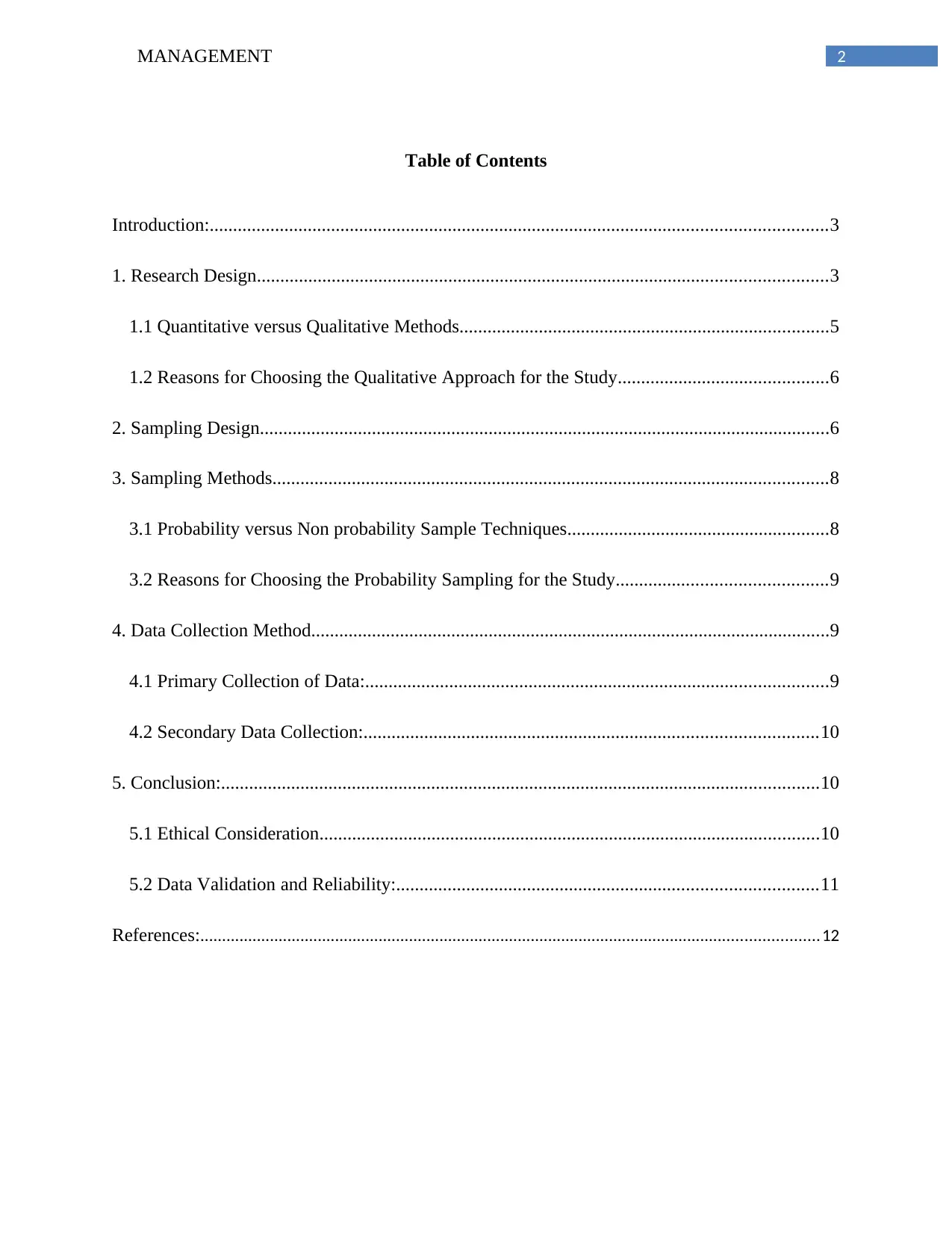
2MANAGEMENT
Table of Contents
Introduction:....................................................................................................................................3
1. Research Design..........................................................................................................................3
1.1 Quantitative versus Qualitative Methods...............................................................................5
1.2 Reasons for Choosing the Qualitative Approach for the Study.............................................6
2. Sampling Design..........................................................................................................................6
3. Sampling Methods.......................................................................................................................8
3.1 Probability versus Non probability Sample Techniques........................................................8
3.2 Reasons for Choosing the Probability Sampling for the Study.............................................9
4. Data Collection Method...............................................................................................................9
4.1 Primary Collection of Data:...................................................................................................9
4.2 Secondary Data Collection:.................................................................................................10
5. Conclusion:................................................................................................................................10
5.1 Ethical Consideration...........................................................................................................10
5.2 Data Validation and Reliability:..........................................................................................11
References:..............................................................................................................................................12
Table of Contents
Introduction:....................................................................................................................................3
1. Research Design..........................................................................................................................3
1.1 Quantitative versus Qualitative Methods...............................................................................5
1.2 Reasons for Choosing the Qualitative Approach for the Study.............................................6
2. Sampling Design..........................................................................................................................6
3. Sampling Methods.......................................................................................................................8
3.1 Probability versus Non probability Sample Techniques........................................................8
3.2 Reasons for Choosing the Probability Sampling for the Study.............................................9
4. Data Collection Method...............................................................................................................9
4.1 Primary Collection of Data:...................................................................................................9
4.2 Secondary Data Collection:.................................................................................................10
5. Conclusion:................................................................................................................................10
5.1 Ethical Consideration...........................................................................................................10
5.2 Data Validation and Reliability:..........................................................................................11
References:..............................................................................................................................................12
⊘ This is a preview!⊘
Do you want full access?
Subscribe today to unlock all pages.

Trusted by 1+ million students worldwide
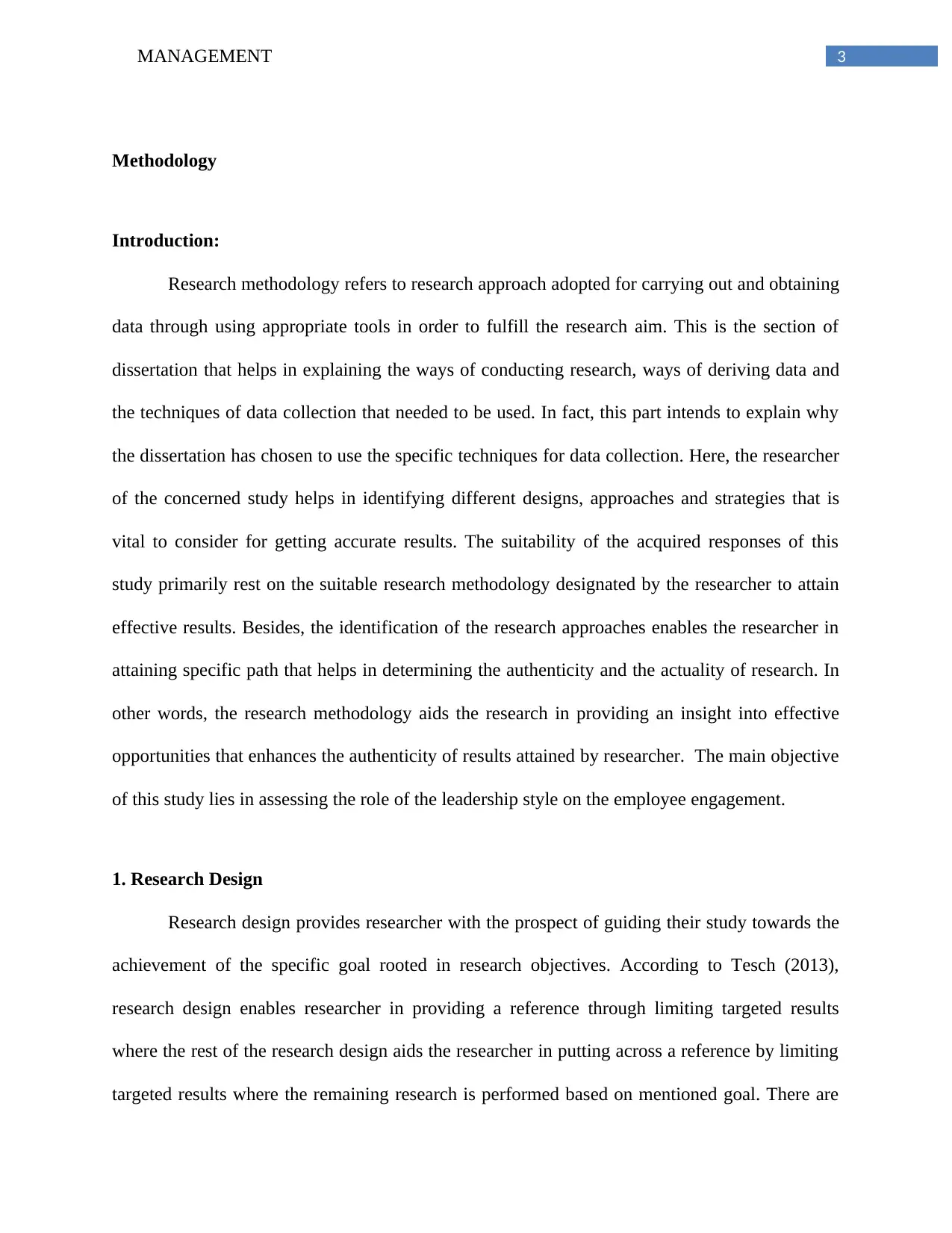
3MANAGEMENT
Methodology
Introduction:
Research methodology refers to research approach adopted for carrying out and obtaining
data through using appropriate tools in order to fulfill the research aim. This is the section of
dissertation that helps in explaining the ways of conducting research, ways of deriving data and
the techniques of data collection that needed to be used. In fact, this part intends to explain why
the dissertation has chosen to use the specific techniques for data collection. Here, the researcher
of the concerned study helps in identifying different designs, approaches and strategies that is
vital to consider for getting accurate results. The suitability of the acquired responses of this
study primarily rest on the suitable research methodology designated by the researcher to attain
effective results. Besides, the identification of the research approaches enables the researcher in
attaining specific path that helps in determining the authenticity and the actuality of research. In
other words, the research methodology aids the research in providing an insight into effective
opportunities that enhances the authenticity of results attained by researcher. The main objective
of this study lies in assessing the role of the leadership style on the employee engagement.
1. Research Design
Research design provides researcher with the prospect of guiding their study towards the
achievement of the specific goal rooted in research objectives. According to Tesch (2013),
research design enables researcher in providing a reference through limiting targeted results
where the rest of the research design aids the researcher in putting across a reference by limiting
targeted results where the remaining research is performed based on mentioned goal. There are
Methodology
Introduction:
Research methodology refers to research approach adopted for carrying out and obtaining
data through using appropriate tools in order to fulfill the research aim. This is the section of
dissertation that helps in explaining the ways of conducting research, ways of deriving data and
the techniques of data collection that needed to be used. In fact, this part intends to explain why
the dissertation has chosen to use the specific techniques for data collection. Here, the researcher
of the concerned study helps in identifying different designs, approaches and strategies that is
vital to consider for getting accurate results. The suitability of the acquired responses of this
study primarily rest on the suitable research methodology designated by the researcher to attain
effective results. Besides, the identification of the research approaches enables the researcher in
attaining specific path that helps in determining the authenticity and the actuality of research. In
other words, the research methodology aids the research in providing an insight into effective
opportunities that enhances the authenticity of results attained by researcher. The main objective
of this study lies in assessing the role of the leadership style on the employee engagement.
1. Research Design
Research design provides researcher with the prospect of guiding their study towards the
achievement of the specific goal rooted in research objectives. According to Tesch (2013),
research design enables researcher in providing a reference through limiting targeted results
where the rest of the research design aids the researcher in putting across a reference by limiting
targeted results where the remaining research is performed based on mentioned goal. There are
Paraphrase This Document
Need a fresh take? Get an instant paraphrase of this document with our AI Paraphraser
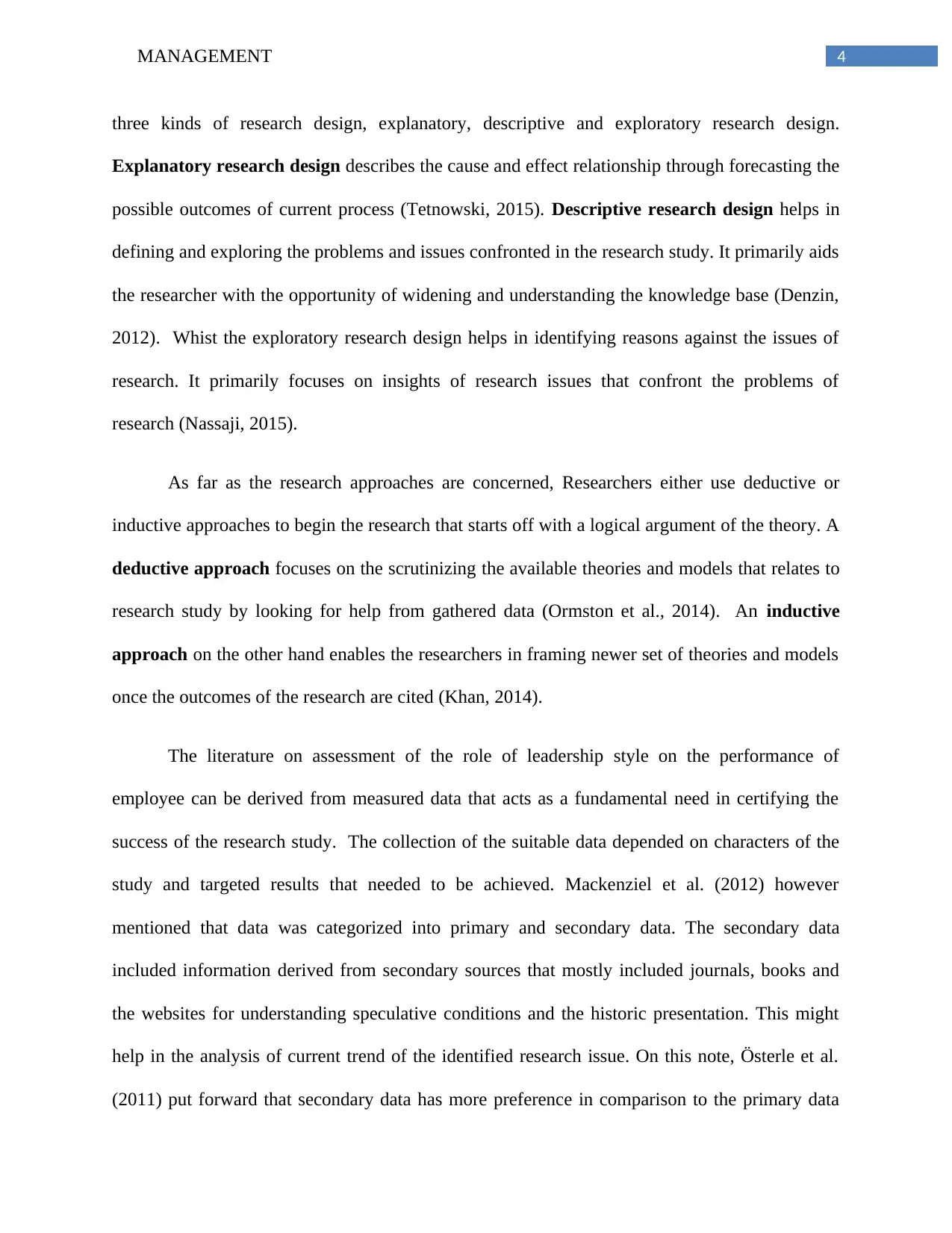
4MANAGEMENT
three kinds of research design, explanatory, descriptive and exploratory research design.
Explanatory research design describes the cause and effect relationship through forecasting the
possible outcomes of current process (Tetnowski, 2015). Descriptive research design helps in
defining and exploring the problems and issues confronted in the research study. It primarily aids
the researcher with the opportunity of widening and understanding the knowledge base (Denzin,
2012). Whist the exploratory research design helps in identifying reasons against the issues of
research. It primarily focuses on insights of research issues that confront the problems of
research (Nassaji, 2015).
As far as the research approaches are concerned, Researchers either use deductive or
inductive approaches to begin the research that starts off with a logical argument of the theory. A
deductive approach focuses on the scrutinizing the available theories and models that relates to
research study by looking for help from gathered data (Ormston et al., 2014). An inductive
approach on the other hand enables the researchers in framing newer set of theories and models
once the outcomes of the research are cited (Khan, 2014).
The literature on assessment of the role of leadership style on the performance of
employee can be derived from measured data that acts as a fundamental need in certifying the
success of the research study. The collection of the suitable data depended on characters of the
study and targeted results that needed to be achieved. Mackenziel et al. (2012) however
mentioned that data was categorized into primary and secondary data. The secondary data
included information derived from secondary sources that mostly included journals, books and
the websites for understanding speculative conditions and the historic presentation. This might
help in the analysis of current trend of the identified research issue. On this note, Österle et al.
(2011) put forward that secondary data has more preference in comparison to the primary data
three kinds of research design, explanatory, descriptive and exploratory research design.
Explanatory research design describes the cause and effect relationship through forecasting the
possible outcomes of current process (Tetnowski, 2015). Descriptive research design helps in
defining and exploring the problems and issues confronted in the research study. It primarily aids
the researcher with the opportunity of widening and understanding the knowledge base (Denzin,
2012). Whist the exploratory research design helps in identifying reasons against the issues of
research. It primarily focuses on insights of research issues that confront the problems of
research (Nassaji, 2015).
As far as the research approaches are concerned, Researchers either use deductive or
inductive approaches to begin the research that starts off with a logical argument of the theory. A
deductive approach focuses on the scrutinizing the available theories and models that relates to
research study by looking for help from gathered data (Ormston et al., 2014). An inductive
approach on the other hand enables the researchers in framing newer set of theories and models
once the outcomes of the research are cited (Khan, 2014).
The literature on assessment of the role of leadership style on the performance of
employee can be derived from measured data that acts as a fundamental need in certifying the
success of the research study. The collection of the suitable data depended on characters of the
study and targeted results that needed to be achieved. Mackenziel et al. (2012) however
mentioned that data was categorized into primary and secondary data. The secondary data
included information derived from secondary sources that mostly included journals, books and
the websites for understanding speculative conditions and the historic presentation. This might
help in the analysis of current trend of the identified research issue. On this note, Österle et al.
(2011) put forward that secondary data has more preference in comparison to the primary data
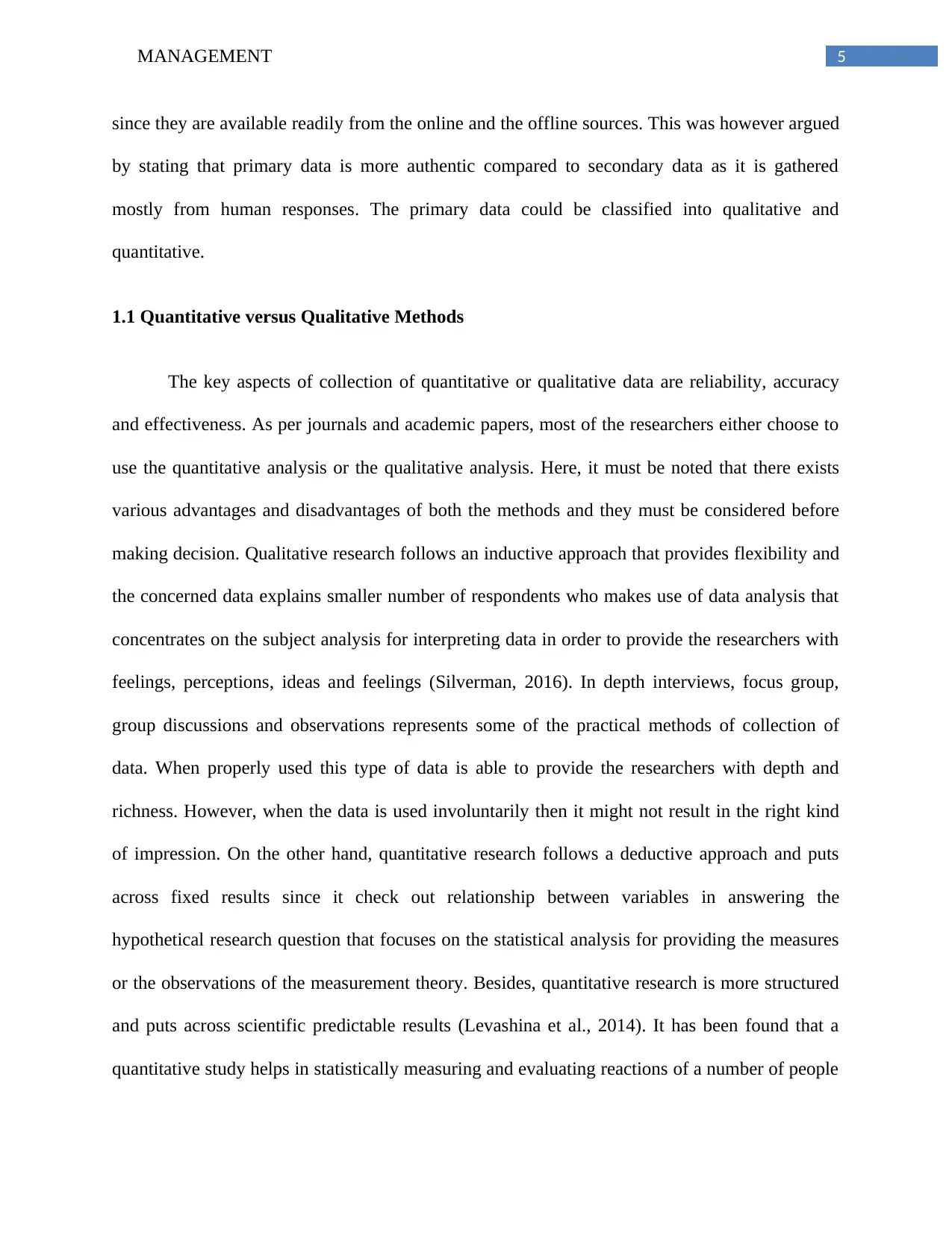
5MANAGEMENT
since they are available readily from the online and the offline sources. This was however argued
by stating that primary data is more authentic compared to secondary data as it is gathered
mostly from human responses. The primary data could be classified into qualitative and
quantitative.
1.1 Quantitative versus Qualitative Methods
The key aspects of collection of quantitative or qualitative data are reliability, accuracy
and effectiveness. As per journals and academic papers, most of the researchers either choose to
use the quantitative analysis or the qualitative analysis. Here, it must be noted that there exists
various advantages and disadvantages of both the methods and they must be considered before
making decision. Qualitative research follows an inductive approach that provides flexibility and
the concerned data explains smaller number of respondents who makes use of data analysis that
concentrates on the subject analysis for interpreting data in order to provide the researchers with
feelings, perceptions, ideas and feelings (Silverman, 2016). In depth interviews, focus group,
group discussions and observations represents some of the practical methods of collection of
data. When properly used this type of data is able to provide the researchers with depth and
richness. However, when the data is used involuntarily then it might not result in the right kind
of impression. On the other hand, quantitative research follows a deductive approach and puts
across fixed results since it check out relationship between variables in answering the
hypothetical research question that focuses on the statistical analysis for providing the measures
or the observations of the measurement theory. Besides, quantitative research is more structured
and puts across scientific predictable results (Levashina et al., 2014). It has been found that a
quantitative study helps in statistically measuring and evaluating reactions of a number of people
since they are available readily from the online and the offline sources. This was however argued
by stating that primary data is more authentic compared to secondary data as it is gathered
mostly from human responses. The primary data could be classified into qualitative and
quantitative.
1.1 Quantitative versus Qualitative Methods
The key aspects of collection of quantitative or qualitative data are reliability, accuracy
and effectiveness. As per journals and academic papers, most of the researchers either choose to
use the quantitative analysis or the qualitative analysis. Here, it must be noted that there exists
various advantages and disadvantages of both the methods and they must be considered before
making decision. Qualitative research follows an inductive approach that provides flexibility and
the concerned data explains smaller number of respondents who makes use of data analysis that
concentrates on the subject analysis for interpreting data in order to provide the researchers with
feelings, perceptions, ideas and feelings (Silverman, 2016). In depth interviews, focus group,
group discussions and observations represents some of the practical methods of collection of
data. When properly used this type of data is able to provide the researchers with depth and
richness. However, when the data is used involuntarily then it might not result in the right kind
of impression. On the other hand, quantitative research follows a deductive approach and puts
across fixed results since it check out relationship between variables in answering the
hypothetical research question that focuses on the statistical analysis for providing the measures
or the observations of the measurement theory. Besides, quantitative research is more structured
and puts across scientific predictable results (Levashina et al., 2014). It has been found that a
quantitative study helps in statistically measuring and evaluating reactions of a number of people
⊘ This is a preview!⊘
Do you want full access?
Subscribe today to unlock all pages.

Trusted by 1+ million students worldwide
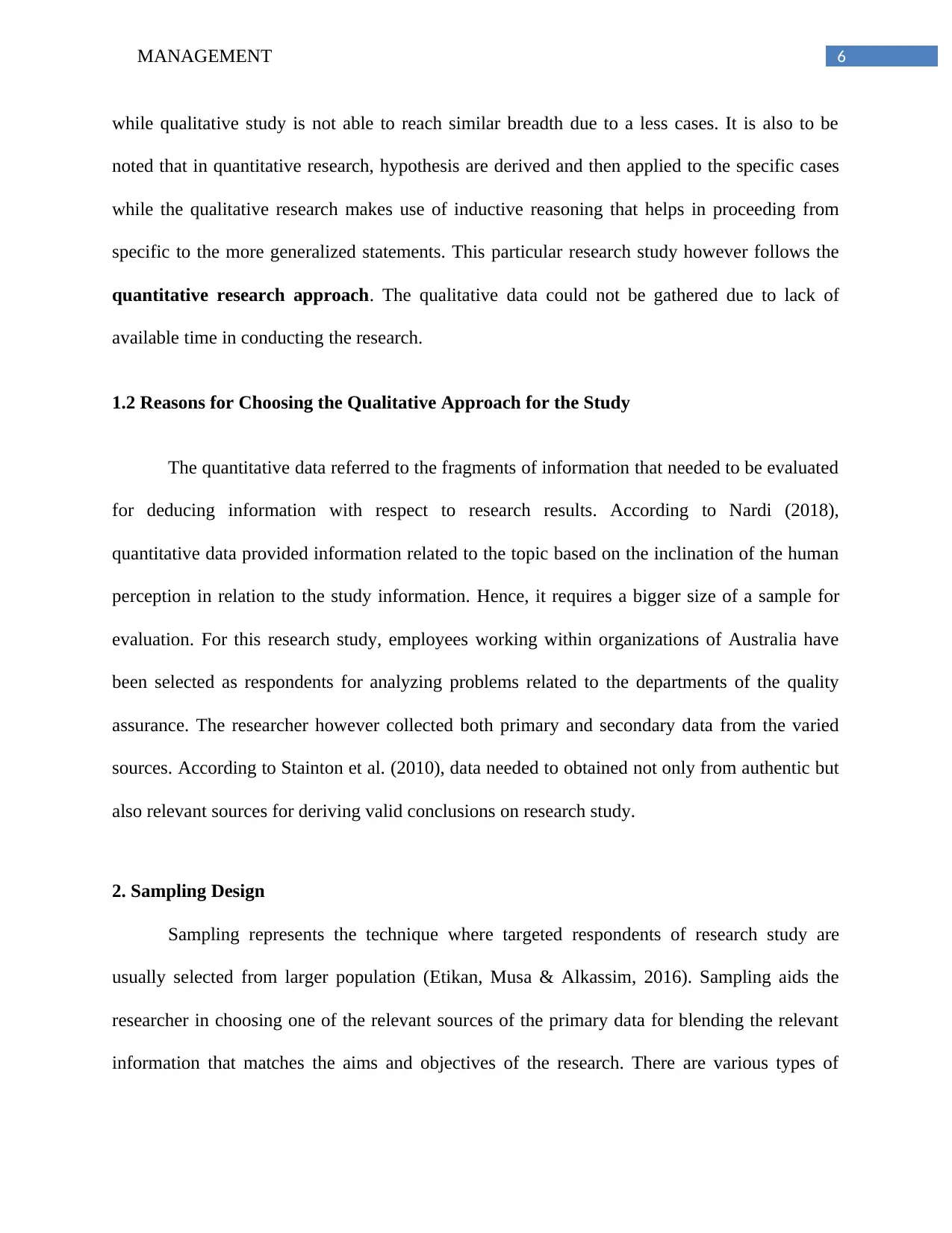
6MANAGEMENT
while qualitative study is not able to reach similar breadth due to a less cases. It is also to be
noted that in quantitative research, hypothesis are derived and then applied to the specific cases
while the qualitative research makes use of inductive reasoning that helps in proceeding from
specific to the more generalized statements. This particular research study however follows the
quantitative research approach. The qualitative data could not be gathered due to lack of
available time in conducting the research.
1.2 Reasons for Choosing the Qualitative Approach for the Study
The quantitative data referred to the fragments of information that needed to be evaluated
for deducing information with respect to research results. According to Nardi (2018),
quantitative data provided information related to the topic based on the inclination of the human
perception in relation to the study information. Hence, it requires a bigger size of a sample for
evaluation. For this research study, employees working within organizations of Australia have
been selected as respondents for analyzing problems related to the departments of the quality
assurance. The researcher however collected both primary and secondary data from the varied
sources. According to Stainton et al. (2010), data needed to obtained not only from authentic but
also relevant sources for deriving valid conclusions on research study.
2. Sampling Design
Sampling represents the technique where targeted respondents of research study are
usually selected from larger population (Etikan, Musa & Alkassim, 2016). Sampling aids the
researcher in choosing one of the relevant sources of the primary data for blending the relevant
information that matches the aims and objectives of the research. There are various types of
while qualitative study is not able to reach similar breadth due to a less cases. It is also to be
noted that in quantitative research, hypothesis are derived and then applied to the specific cases
while the qualitative research makes use of inductive reasoning that helps in proceeding from
specific to the more generalized statements. This particular research study however follows the
quantitative research approach. The qualitative data could not be gathered due to lack of
available time in conducting the research.
1.2 Reasons for Choosing the Qualitative Approach for the Study
The quantitative data referred to the fragments of information that needed to be evaluated
for deducing information with respect to research results. According to Nardi (2018),
quantitative data provided information related to the topic based on the inclination of the human
perception in relation to the study information. Hence, it requires a bigger size of a sample for
evaluation. For this research study, employees working within organizations of Australia have
been selected as respondents for analyzing problems related to the departments of the quality
assurance. The researcher however collected both primary and secondary data from the varied
sources. According to Stainton et al. (2010), data needed to obtained not only from authentic but
also relevant sources for deriving valid conclusions on research study.
2. Sampling Design
Sampling represents the technique where targeted respondents of research study are
usually selected from larger population (Etikan, Musa & Alkassim, 2016). Sampling aids the
researcher in choosing one of the relevant sources of the primary data for blending the relevant
information that matches the aims and objectives of the research. There are various types of
Paraphrase This Document
Need a fresh take? Get an instant paraphrase of this document with our AI Paraphraser
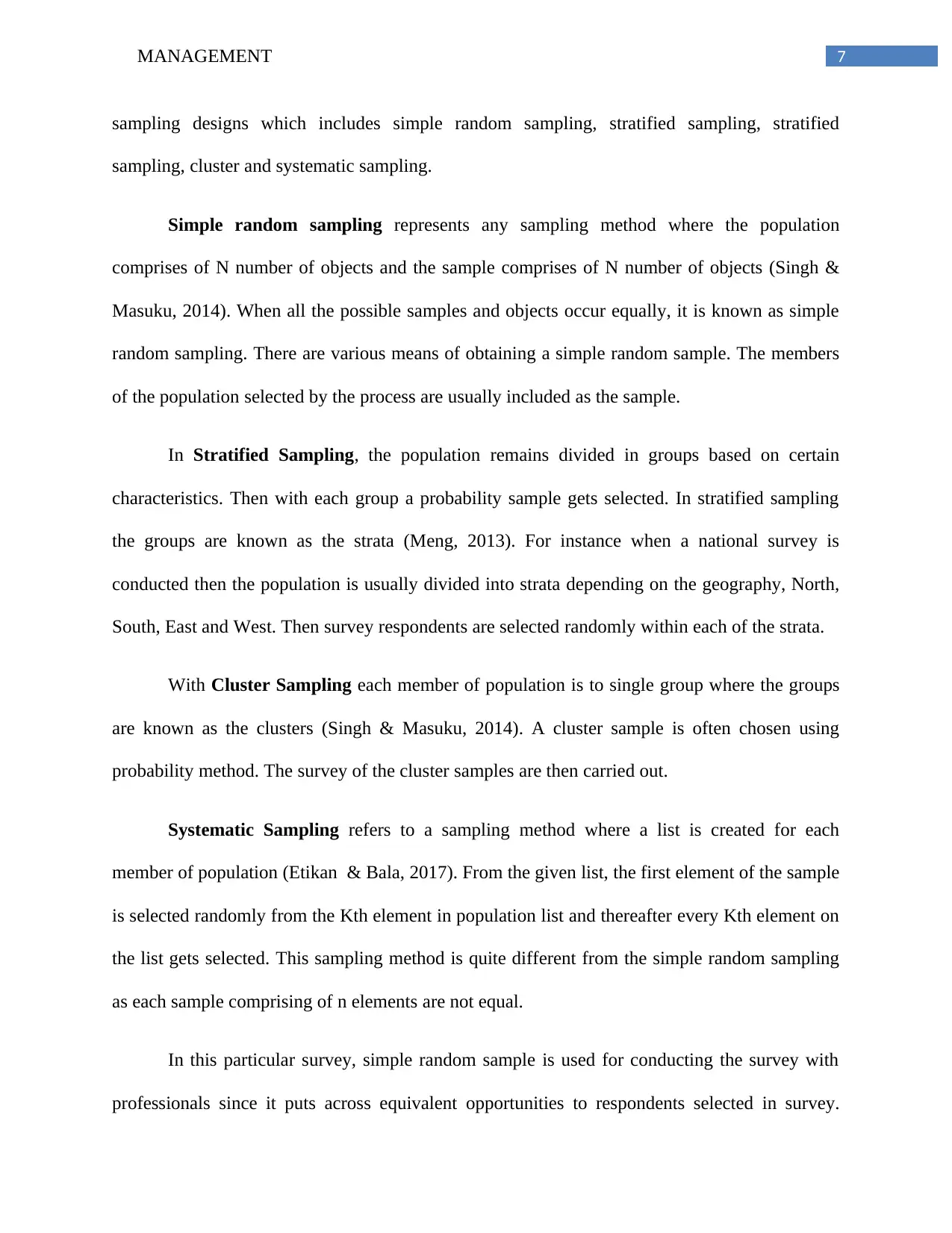
7MANAGEMENT
sampling designs which includes simple random sampling, stratified sampling, stratified
sampling, cluster and systematic sampling.
Simple random sampling represents any sampling method where the population
comprises of N number of objects and the sample comprises of N number of objects (Singh &
Masuku, 2014). When all the possible samples and objects occur equally, it is known as simple
random sampling. There are various means of obtaining a simple random sample. The members
of the population selected by the process are usually included as the sample.
In Stratified Sampling, the population remains divided in groups based on certain
characteristics. Then with each group a probability sample gets selected. In stratified sampling
the groups are known as the strata (Meng, 2013). For instance when a national survey is
conducted then the population is usually divided into strata depending on the geography, North,
South, East and West. Then survey respondents are selected randomly within each of the strata.
With Cluster Sampling each member of population is to single group where the groups
are known as the clusters (Singh & Masuku, 2014). A cluster sample is often chosen using
probability method. The survey of the cluster samples are then carried out.
Systematic Sampling refers to a sampling method where a list is created for each
member of population (Etikan & Bala, 2017). From the given list, the first element of the sample
is selected randomly from the Kth element in population list and thereafter every Kth element on
the list gets selected. This sampling method is quite different from the simple random sampling
as each sample comprising of n elements are not equal.
In this particular survey, simple random sample is used for conducting the survey with
professionals since it puts across equivalent opportunities to respondents selected in survey.
sampling designs which includes simple random sampling, stratified sampling, stratified
sampling, cluster and systematic sampling.
Simple random sampling represents any sampling method where the population
comprises of N number of objects and the sample comprises of N number of objects (Singh &
Masuku, 2014). When all the possible samples and objects occur equally, it is known as simple
random sampling. There are various means of obtaining a simple random sample. The members
of the population selected by the process are usually included as the sample.
In Stratified Sampling, the population remains divided in groups based on certain
characteristics. Then with each group a probability sample gets selected. In stratified sampling
the groups are known as the strata (Meng, 2013). For instance when a national survey is
conducted then the population is usually divided into strata depending on the geography, North,
South, East and West. Then survey respondents are selected randomly within each of the strata.
With Cluster Sampling each member of population is to single group where the groups
are known as the clusters (Singh & Masuku, 2014). A cluster sample is often chosen using
probability method. The survey of the cluster samples are then carried out.
Systematic Sampling refers to a sampling method where a list is created for each
member of population (Etikan & Bala, 2017). From the given list, the first element of the sample
is selected randomly from the Kth element in population list and thereafter every Kth element on
the list gets selected. This sampling method is quite different from the simple random sampling
as each sample comprising of n elements are not equal.
In this particular survey, simple random sample is used for conducting the survey with
professionals since it puts across equivalent opportunities to respondents selected in survey.
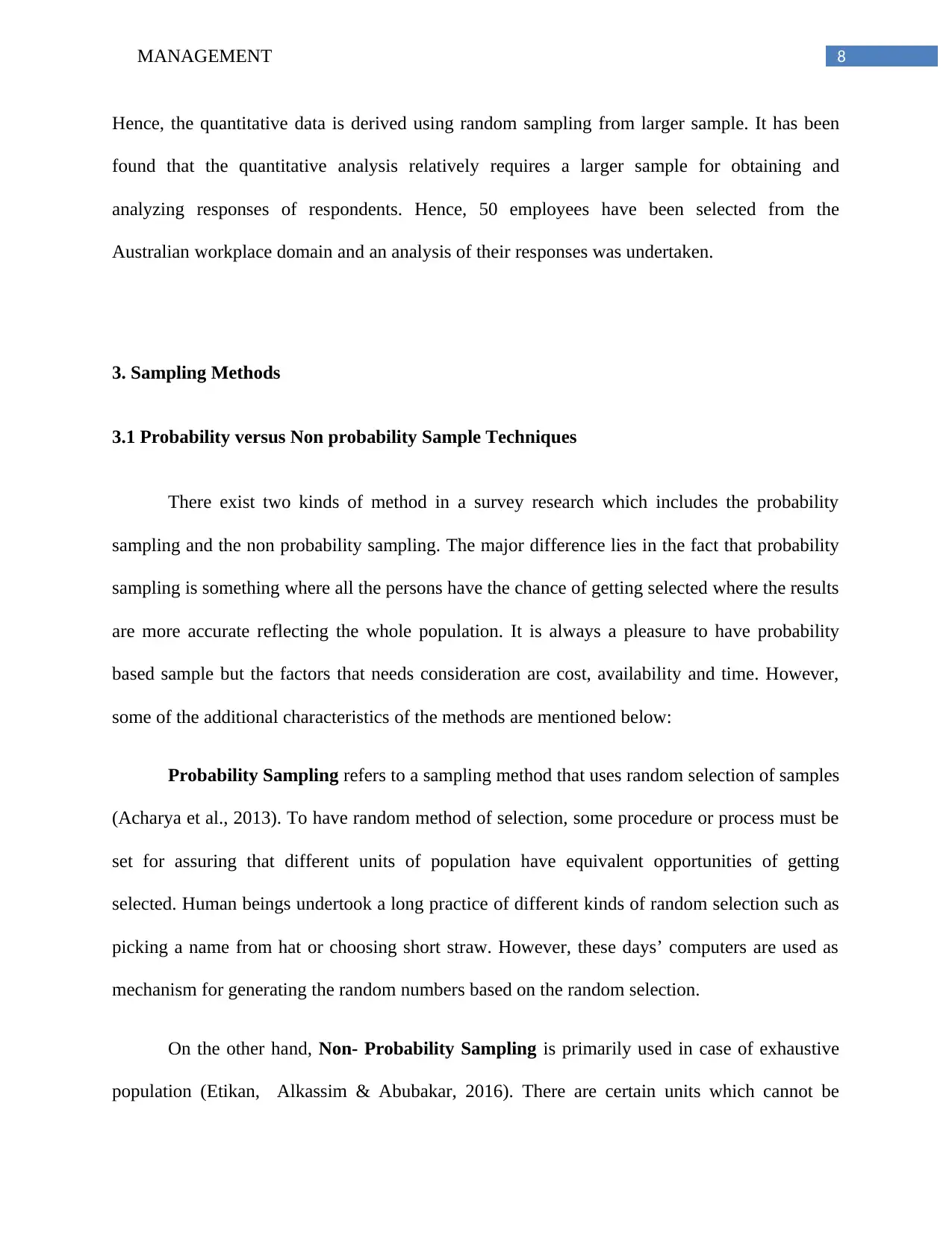
8MANAGEMENT
Hence, the quantitative data is derived using random sampling from larger sample. It has been
found that the quantitative analysis relatively requires a larger sample for obtaining and
analyzing responses of respondents. Hence, 50 employees have been selected from the
Australian workplace domain and an analysis of their responses was undertaken.
3. Sampling Methods
3.1 Probability versus Non probability Sample Techniques
There exist two kinds of method in a survey research which includes the probability
sampling and the non probability sampling. The major difference lies in the fact that probability
sampling is something where all the persons have the chance of getting selected where the results
are more accurate reflecting the whole population. It is always a pleasure to have probability
based sample but the factors that needs consideration are cost, availability and time. However,
some of the additional characteristics of the methods are mentioned below:
Probability Sampling refers to a sampling method that uses random selection of samples
(Acharya et al., 2013). To have random method of selection, some procedure or process must be
set for assuring that different units of population have equivalent opportunities of getting
selected. Human beings undertook a long practice of different kinds of random selection such as
picking a name from hat or choosing short straw. However, these days’ computers are used as
mechanism for generating the random numbers based on the random selection.
On the other hand, Non- Probability Sampling is primarily used in case of exhaustive
population (Etikan, Alkassim & Abubakar, 2016). There are certain units which cannot be
Hence, the quantitative data is derived using random sampling from larger sample. It has been
found that the quantitative analysis relatively requires a larger sample for obtaining and
analyzing responses of respondents. Hence, 50 employees have been selected from the
Australian workplace domain and an analysis of their responses was undertaken.
3. Sampling Methods
3.1 Probability versus Non probability Sample Techniques
There exist two kinds of method in a survey research which includes the probability
sampling and the non probability sampling. The major difference lies in the fact that probability
sampling is something where all the persons have the chance of getting selected where the results
are more accurate reflecting the whole population. It is always a pleasure to have probability
based sample but the factors that needs consideration are cost, availability and time. However,
some of the additional characteristics of the methods are mentioned below:
Probability Sampling refers to a sampling method that uses random selection of samples
(Acharya et al., 2013). To have random method of selection, some procedure or process must be
set for assuring that different units of population have equivalent opportunities of getting
selected. Human beings undertook a long practice of different kinds of random selection such as
picking a name from hat or choosing short straw. However, these days’ computers are used as
mechanism for generating the random numbers based on the random selection.
On the other hand, Non- Probability Sampling is primarily used in case of exhaustive
population (Etikan, Alkassim & Abubakar, 2016). There are certain units which cannot be
⊘ This is a preview!⊘
Do you want full access?
Subscribe today to unlock all pages.

Trusted by 1+ million students worldwide
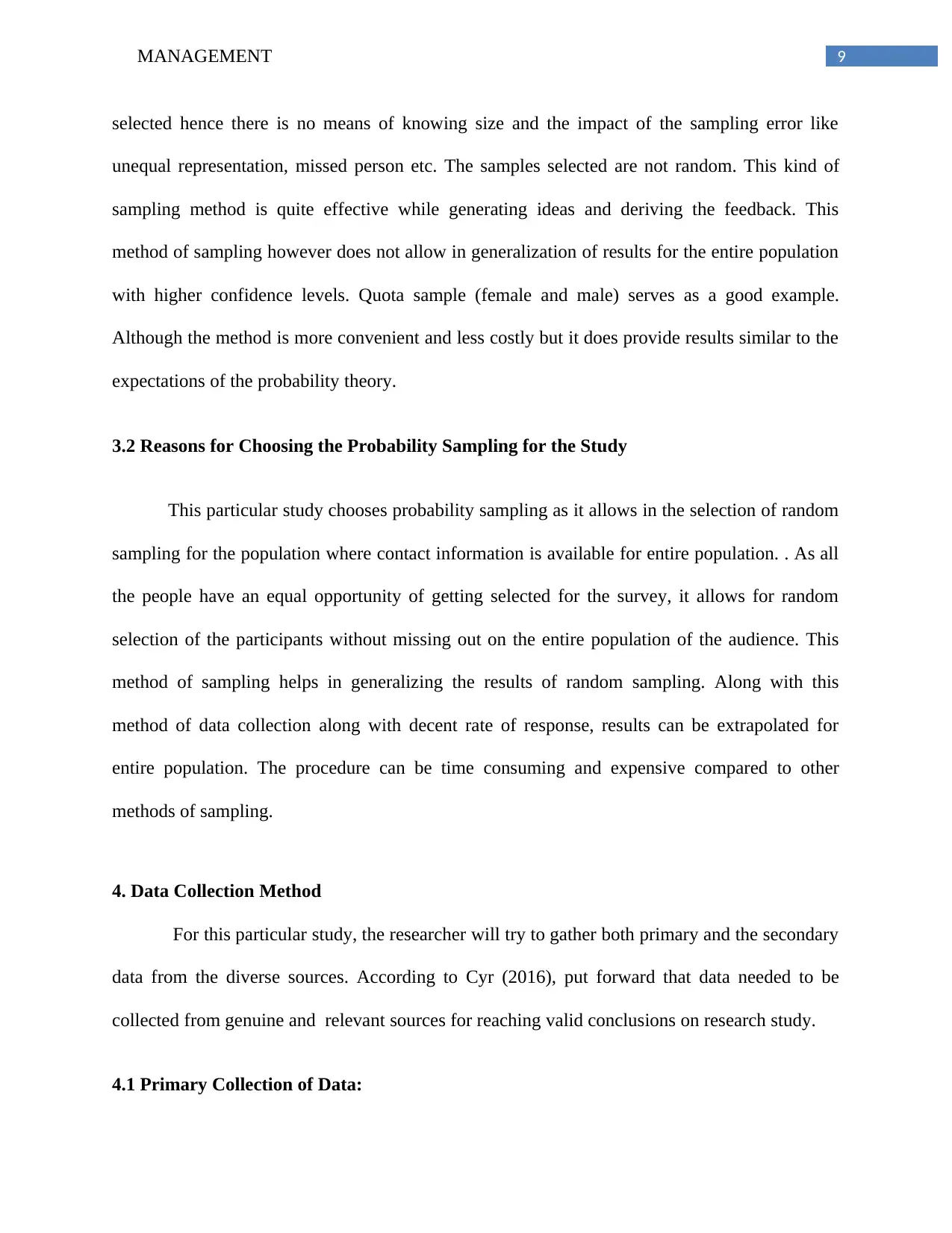
9MANAGEMENT
selected hence there is no means of knowing size and the impact of the sampling error like
unequal representation, missed person etc. The samples selected are not random. This kind of
sampling method is quite effective while generating ideas and deriving the feedback. This
method of sampling however does not allow in generalization of results for the entire population
with higher confidence levels. Quota sample (female and male) serves as a good example.
Although the method is more convenient and less costly but it does provide results similar to the
expectations of the probability theory.
3.2 Reasons for Choosing the Probability Sampling for the Study
This particular study chooses probability sampling as it allows in the selection of random
sampling for the population where contact information is available for entire population. . As all
the people have an equal opportunity of getting selected for the survey, it allows for random
selection of the participants without missing out on the entire population of the audience. This
method of sampling helps in generalizing the results of random sampling. Along with this
method of data collection along with decent rate of response, results can be extrapolated for
entire population. The procedure can be time consuming and expensive compared to other
methods of sampling.
4. Data Collection Method
For this particular study, the researcher will try to gather both primary and the secondary
data from the diverse sources. According to Cyr (2016), put forward that data needed to be
collected from genuine and relevant sources for reaching valid conclusions on research study.
4.1 Primary Collection of Data:
selected hence there is no means of knowing size and the impact of the sampling error like
unequal representation, missed person etc. The samples selected are not random. This kind of
sampling method is quite effective while generating ideas and deriving the feedback. This
method of sampling however does not allow in generalization of results for the entire population
with higher confidence levels. Quota sample (female and male) serves as a good example.
Although the method is more convenient and less costly but it does provide results similar to the
expectations of the probability theory.
3.2 Reasons for Choosing the Probability Sampling for the Study
This particular study chooses probability sampling as it allows in the selection of random
sampling for the population where contact information is available for entire population. . As all
the people have an equal opportunity of getting selected for the survey, it allows for random
selection of the participants without missing out on the entire population of the audience. This
method of sampling helps in generalizing the results of random sampling. Along with this
method of data collection along with decent rate of response, results can be extrapolated for
entire population. The procedure can be time consuming and expensive compared to other
methods of sampling.
4. Data Collection Method
For this particular study, the researcher will try to gather both primary and the secondary
data from the diverse sources. According to Cyr (2016), put forward that data needed to be
collected from genuine and relevant sources for reaching valid conclusions on research study.
4.1 Primary Collection of Data:
Paraphrase This Document
Need a fresh take? Get an instant paraphrase of this document with our AI Paraphraser
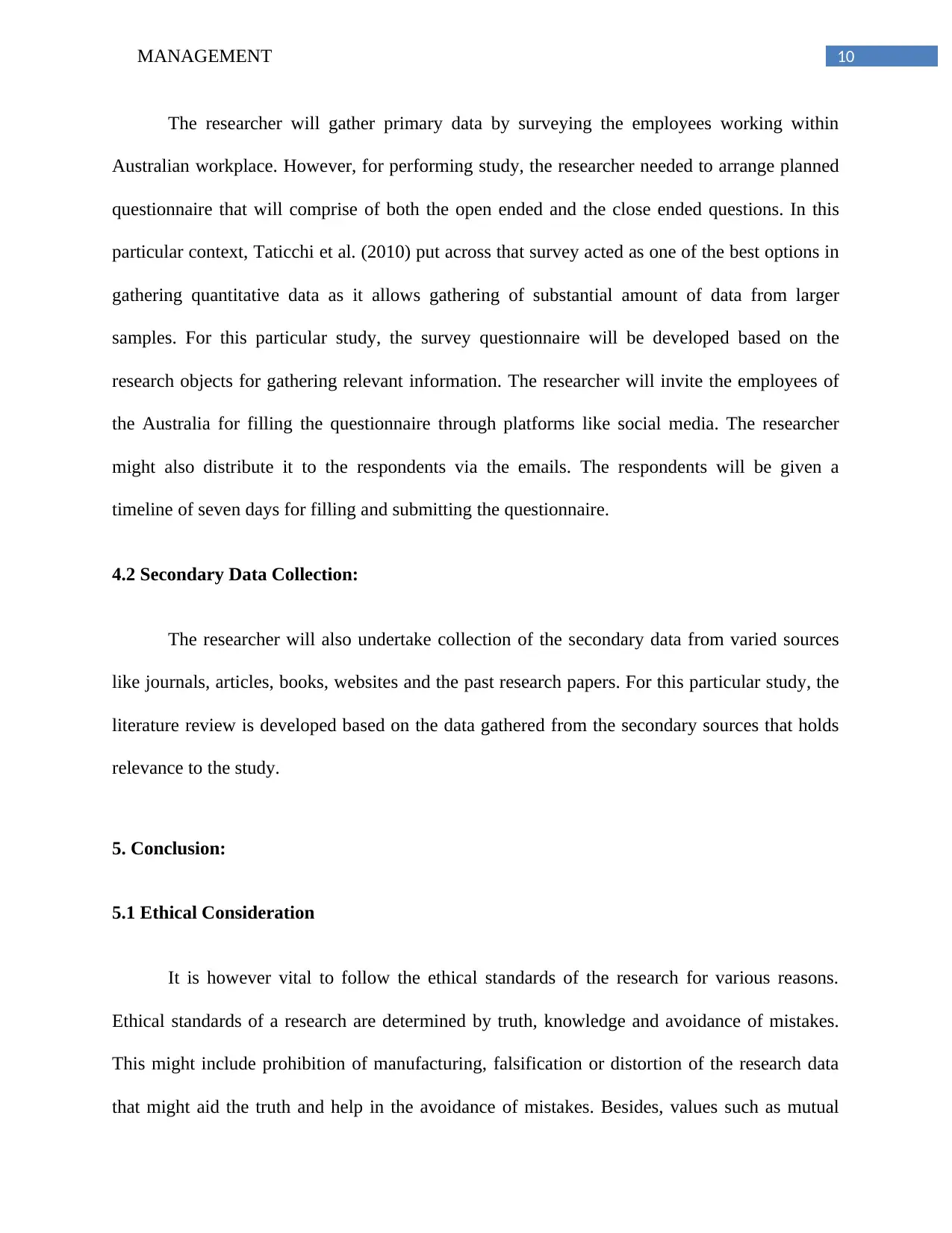
10MANAGEMENT
The researcher will gather primary data by surveying the employees working within
Australian workplace. However, for performing study, the researcher needed to arrange planned
questionnaire that will comprise of both the open ended and the close ended questions. In this
particular context, Taticchi et al. (2010) put across that survey acted as one of the best options in
gathering quantitative data as it allows gathering of substantial amount of data from larger
samples. For this particular study, the survey questionnaire will be developed based on the
research objects for gathering relevant information. The researcher will invite the employees of
the Australia for filling the questionnaire through platforms like social media. The researcher
might also distribute it to the respondents via the emails. The respondents will be given a
timeline of seven days for filling and submitting the questionnaire.
4.2 Secondary Data Collection:
The researcher will also undertake collection of the secondary data from varied sources
like journals, articles, books, websites and the past research papers. For this particular study, the
literature review is developed based on the data gathered from the secondary sources that holds
relevance to the study.
5. Conclusion:
5.1 Ethical Consideration
It is however vital to follow the ethical standards of the research for various reasons.
Ethical standards of a research are determined by truth, knowledge and avoidance of mistakes.
This might include prohibition of manufacturing, falsification or distortion of the research data
that might aid the truth and help in the avoidance of mistakes. Besides, values such as mutual
The researcher will gather primary data by surveying the employees working within
Australian workplace. However, for performing study, the researcher needed to arrange planned
questionnaire that will comprise of both the open ended and the close ended questions. In this
particular context, Taticchi et al. (2010) put across that survey acted as one of the best options in
gathering quantitative data as it allows gathering of substantial amount of data from larger
samples. For this particular study, the survey questionnaire will be developed based on the
research objects for gathering relevant information. The researcher will invite the employees of
the Australia for filling the questionnaire through platforms like social media. The researcher
might also distribute it to the respondents via the emails. The respondents will be given a
timeline of seven days for filling and submitting the questionnaire.
4.2 Secondary Data Collection:
The researcher will also undertake collection of the secondary data from varied sources
like journals, articles, books, websites and the past research papers. For this particular study, the
literature review is developed based on the data gathered from the secondary sources that holds
relevance to the study.
5. Conclusion:
5.1 Ethical Consideration
It is however vital to follow the ethical standards of the research for various reasons.
Ethical standards of a research are determined by truth, knowledge and avoidance of mistakes.
This might include prohibition of manufacturing, falsification or distortion of the research data
that might aid the truth and help in the avoidance of mistakes. Besides, values such as mutual
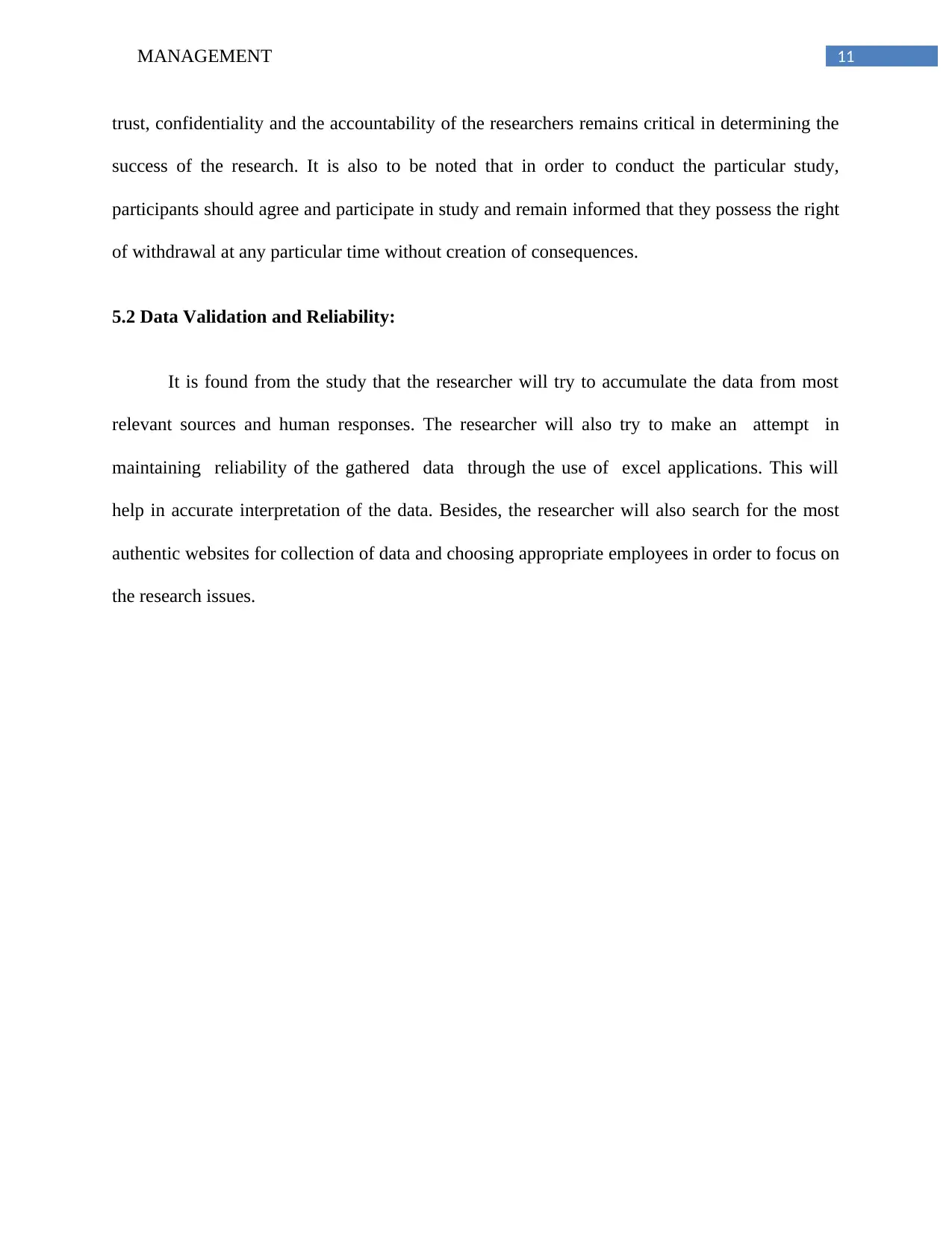
11MANAGEMENT
trust, confidentiality and the accountability of the researchers remains critical in determining the
success of the research. It is also to be noted that in order to conduct the particular study,
participants should agree and participate in study and remain informed that they possess the right
of withdrawal at any particular time without creation of consequences.
5.2 Data Validation and Reliability:
It is found from the study that the researcher will try to accumulate the data from most
relevant sources and human responses. The researcher will also try to make an attempt in
maintaining reliability of the gathered data through the use of excel applications. This will
help in accurate interpretation of the data. Besides, the researcher will also search for the most
authentic websites for collection of data and choosing appropriate employees in order to focus on
the research issues.
trust, confidentiality and the accountability of the researchers remains critical in determining the
success of the research. It is also to be noted that in order to conduct the particular study,
participants should agree and participate in study and remain informed that they possess the right
of withdrawal at any particular time without creation of consequences.
5.2 Data Validation and Reliability:
It is found from the study that the researcher will try to accumulate the data from most
relevant sources and human responses. The researcher will also try to make an attempt in
maintaining reliability of the gathered data through the use of excel applications. This will
help in accurate interpretation of the data. Besides, the researcher will also search for the most
authentic websites for collection of data and choosing appropriate employees in order to focus on
the research issues.
⊘ This is a preview!⊘
Do you want full access?
Subscribe today to unlock all pages.

Trusted by 1+ million students worldwide
1 out of 15
Related Documents
Your All-in-One AI-Powered Toolkit for Academic Success.
+13062052269
info@desklib.com
Available 24*7 on WhatsApp / Email
![[object Object]](/_next/static/media/star-bottom.7253800d.svg)
Unlock your academic potential
Copyright © 2020–2025 A2Z Services. All Rights Reserved. Developed and managed by ZUCOL.





